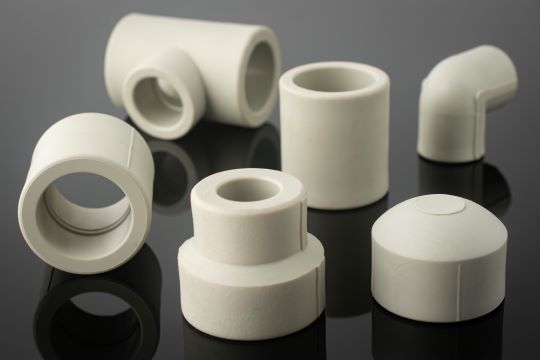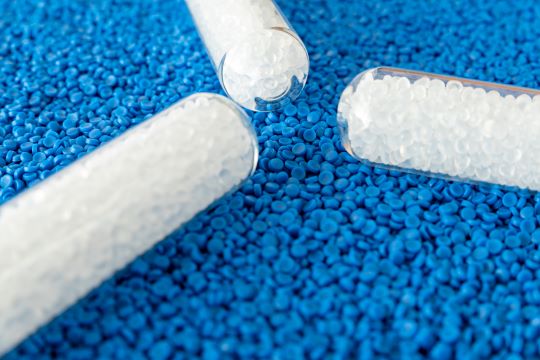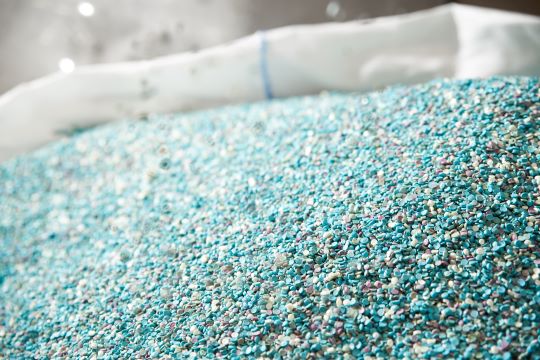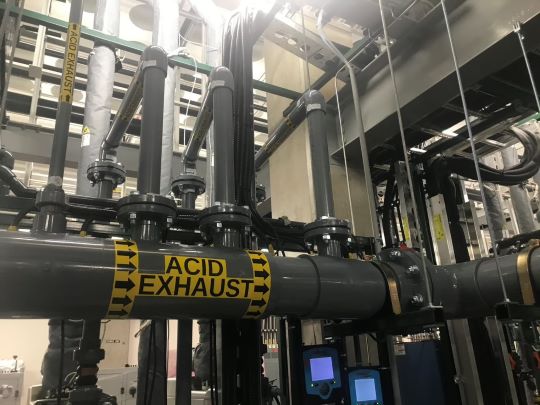In the 1967 film “The Graduate,” the single word "plastics" symbolized the promise of the future. Today, in the battle against corrosion, the future belongs to a more specialized class of materials: thermoplastics.
“Thermoplastics are inherently resistant to corrosion, and advancements continue to create more robust, longer-lasting, and more sustainable solutions,” writes Bryan Hutton, president of Composites USA, in his 2024 AMPP conference paper, “The Evolution of Thermoplastics as a Solution to MIC (microbiologically influenced corrosion) and Oxidative Corrosion Issues.”
Corrosion costs industries billions annually. While traditional methods often focus on metal-based solutions like protective coatings and alloys, thermoplastics are increasingly becoming a viable alternative, particularly in highly corrosive environments. Hutton points out that industries such as offshore drilling, chemical processing, and paper production benefit greatly from thermoplastics' corrosion resistance and lighter weight.
“There are multiple reasons why thermoplastics are gaining favor,” Hutton explains. “It depends on the end user’s needs, but the two biggest factors are corrosion resistance and weight. Unlike metals, thermoplastics don’t corrode and are significantly lighter.”
Defining Thermoplastics and Thermosets
Hutton, who has more than 30 years of chemical industry experience, outlines how thermoplastic materials meet critical engineering standards such as ASME B31.3 for process piping. Though thermoplastics may not be suitable for every application, industries that need longer service life, lightweight materials, and superior corrosion resistance can benefit, he says.
While thermoplastics and thermosets have been used for decades, new material combinations make them increasingly viable. Hutton emphasizes that thermoplastics are seeing expanded use in sectors such as offshore processing, chlor-alkali production, semiconductor manufacturing, metal pickling, and pulp and paper industries.
He has been with Composites USA—a fiberglass-reinforced plastic (FRP) manufacturer in North East, Maryland, USA—for about a year and a half. Composites USA specializes in designing and manufacturing FRP products primarily for use in corrosive environments. Its products include custom FRP tanks, ducts, stacks, scrubbers, hoods, and process equipment.

Hutton refers to the ASME NM.1 standard, defining thermoplastics as “a polymer that can be repeatedly softened by an increase in temperature and hardened by a decrease in temperature.” In contrast, thermosets “are resins that become infusible or insoluble once cured.”
Although these definitions seem straightforward, applying thermoplastics to practical applications, such as piping or tanks, can be complex. Hutton outlines three primary classifications of plastics found in most applications:
- Amorphous polymers, such as polyvinyl chloride and chlorinated polyvinyl chloride (CPVC), do not have a melting point. They may be fused using heat fusion or cementing methods.
- Semicrystalline polymers such as high-density polyethylene, polyvinylidene fluoride, polypropylene, and ethylene chlorotrifluoroethylene are typically used above their glass transition temperature and below their melting point. These types of plastics can be heat-fused but may not be cemented.
- Thermoset polymers such as fiber-reinforced thermosetting-resin utilize chemical curing and heat curing and can neither be fused nor cemented. The resins utilized to manufacture FRP components have varying properties that can provide robust and chemically resistant systems.
Real-World Examples of Thermoplastic Use
The paper highlights how industries use thermoplastics to handle corrosive chemicals like sulfuric acid, sodium hydroxide, and chlorine dioxide. Hutton stresses the importance of selecting the right materials and installation methods to solve corrosion challenges.
“In facilities handling harsh chemicals such as hydrochloric acid or sulfuric acid, common in water treatment or chemical manufacturing, traditional materials like carbon steel are prone to corrosion. In these cases, thermoplastics offer a superior alternative,” says Hutton, who presented his paper at the 2024 AMPP Annual Conference + Expo in New Orleans, Louisiana, USA in March.
He recalls his experience at Lubrizol, where his team gained U.S. Coast Guard approval for using CPVC in offshore platforms, significantly reducing the weight and expense compared to copper-nickel alloys.
Hutton also cites the growing use of polybutylene piping on modern cruise ships as an example of how thermoplastics can outperform metals in terms of cost, weight, and corrosion resistance.
“These are just a few examples, but they illustrate how thermoplastics outperform metals in cost, weight, and resistance to corrosion,” Hutton says.

Considerations for Project Managers
Hutton’s paper urges project and operations managers to weigh factors such as cost, safety, and durability when selecting materials. To maximize the effectiveness of thermoplastics, engineers must consider variables like pressure, temperature, and specific material properties.
He emphasizes that not all plastic piping materials are created equal. Proper understanding of the different types of materials and their polymer structures is crucial for successful application.
Hutton also advocates for better education and training for engineers on thermoplastics and their applications.
“Our engineers … must be better trained in the accredited education system on thermoplastics, polymer science, or material selection techniques,” he writes in the paper. “True to the purpose of AMPP, this paper is built on the premise of providing AMPP members with the knowledge and resources to ensure high-performance materials are used to develop and maintain sustainable infrastructure.”
Knowledge gaps and the slow development of relevant ASME standards have led to misconceptions about the capabilities of thermoplastics, he says.
“Ultimately, the reality is that there are no bad materials, only bad applications of those materials,” he says.

Joining Methods
Thermoplastic welding is the molecular joining of two pieces of plastic using a combination of heat, pressure, and time, Hutton’s paper explains.
“As thermoplastics are heated, they enter a thermoplastic state where the molecular chains become mobile,” he writes. “During this thermoplastic state, two pieces of plastic can be pressed together, allowing the molecular chains to intertwine. As these pieces cool, the bond strengthens and solidifies.”
One drawback of thermoplastics, he notes, is that these welds cannot be tested through nondestructive means.
Hutton lists these methods of joining plastics:
- Solvent cement welding– While some argue this is not actual “welding,” this does fall into the welding category because an actual chemical bond takes place.
- Hot gas hand welding–A manual process using filler material (welding rod) that requires a transfer medium (usually hot air) to heat parent and filler material. The operator applies pressure and controls speed.
- Hot gas extrusion welding–A manual process using filler material (welding rod) pressed out of a melting device as a plasticized cord. The welding filler is homogeneous and plasticized. The joining areas are heated up using hot air. The extruded material is distributed and pressed on by a Teflon shoe.
- Heated tool butt welding–A manual or semi-automatic process where two pieces of material are pressed against a non-stick coated hot plate for a specified time under force, the hot plate is removed, and the two pieces are pressed together. No filler material is introduced.
- Socket fusion–A heated tool welding process variation in which the tool is configured to heat the outside of one workpiece and the inside of the other.
- Electrofusion welding–A resistant implant welding used to join pipes. A fitting with implanted coils is placed around two pieces of pipe, an electric current is passed through the coils, and the pieces are joined.
- Infrared welding–A non-contact method using radiation to transfer energy to a heat pipe, after which the pipe is pressed together under specified force and correlating time depending on material type.
- Friction welding–A method using vibration or rotation to transfer energy, creating heat to perform welding under specified force and correlating time.
- Ultrasonic welding–Uses high frequency, low amplitude vibration to create heat between the two pieces to be joined, again under specified force with correlating weld times.
The Future of Thermoplastics
With the growing demand for critical minerals used in electric vehicle batteries and other technologies, thermoplastics will play an increasingly important role in handling and processing these materials safely, Hutton says. Thermoplastics and thermosets are essential for refining processes like leaching, which separates and concentrates rare earth elements.
Hutton notes that thermoplastics are already used throughout manufacturing plants like Tesla and Panasonic and will continue to be vital as industries evolve.

The shift toward a clean energy economy relies heavily on thermoplastics to safely manage the essential components used in the production of computers, household devices, and clean energy technologies, including batteries, electric vehicles, wind turbines, and solar panels,
Hutton’s paper says. As this transition accelerates, the global demand for critical minerals is expected to surge by 400% to 600% in the coming decades, with minerals such as lithium and graphite, which are key for electric vehicle (EV) batteries, seeing demand increases as high as 4,000%.
“When properly applied, thermoplastics can last significantly longer than metals,” he says. “Manufacturers may offer warranties of 20 to 50 years, but under ideal conditions, thermoplastics could theoretically last over 100 years.”
Editor’s note: This article first appeared in the December 2024 print issue of Materials Performance (MP) Magazine. Reprinted with permission.